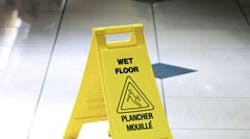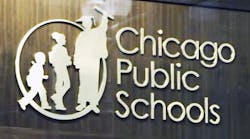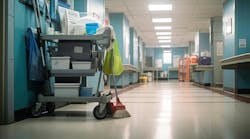As students and teachers return to the classroom for the start of a new school term, building managers and maintenance staff already have been hard at work preparing facilities for another year of art and science projects, cafeteria lunches, sports and other activities. As building managers are aware, a school may start out looking clean and sanitary, but without proper maintenance, it soon can become dirty and unhealthful for all building occupants.
A dirty school can cause students and staff to become ill and create an environment that is unfit for learning. However, keeping a school clean can present dangers as well. If cleaning chemicals are required, exposure to toxic fumes over a prolonged period of time may harm students and cleaning staff.
To keep schools clean without posing any danger to the cleaning staff, faculty or students, building managers should take care in developing and managing a daily maintenance system. This system should include a daily cleaning plan that is developed in conjunction with all parties affected and performed by properly trained cleaning staff. A well-managed maintenance system helps keep cleaning staff, students and faculty safe, and it can provide benefits that will last well beyond the new school year.
Coming together
When creating a daily cleaning plan, building managers need to be aware that such a schedule will affect numerous groups. Therefore, in order to design a cleaning plan that will keep everyone involved healthy and safe, building managers should conduct two meetings.
In the first meeting, building managers and school administrators should study a typical school day and determine the best time for cleaning. Building managers should note high-traffic areas and review a schedule of classroom usage to determine how often cleaning should take place each day. In universities, which typically have less uniform schedules, building managers may have to create two cleaning schedules: one for “Monday, Wednesday and Friday” and one for “Tuesday and Thursday.”
The second meeting should include as many members of the school community as possible. This enables building managers to hear the immediate concerns of teachers, parents, students and other faculty, and helps to create long-term lines of communication among all parties. Establishing this connection to the school community early on can be a valuable asset throughout the year, as teachers and students become comfortable about reporting maintenance problems.
Following these two meetings, building managers and cleaning staff should create a daily cleaning schedule that calls for cleaning to occur at times that cause the least distraction to students and teachers. Building managers also may want to assign a staff member to act as a floor monitor to handle small cleaning tasks as they occur throughout the day.
All aboard for training
In order to keep everyone on the school campus safe during cleaning, the maintenance staff must be trained properly. Building managers should stress the importance of donning protective safety gear before cleaning, as this can keep staff safe from chemical spills. Workers should wear goggles and gloves at all times and should prepare cleaning carts before cleaning commences. Cleaning staff also should be familiar with dilution-control procedures and should know how to fill any spray bottles and buckets with solution before cleaning an area.
Cleaning staff also must remember to place cautionary signs in the doorways of rooms being cleaned. Doing this will alert students and staff that cleaning is taking place and keep them from slipping on wet surfaces or tripping on cords. Schools also should train cleaning staff to use green products such as microfiber cloths and dual-compartment buckets. These tools have been proven to eliminate bacteria and prevent cross-contamination more effectively than conventional tools and reduce the amount of cleaning chemicals required.
Finally, building managers should visit classrooms to provide tips to students and teachers for safely maintaining classrooms. They can demonstrate how to handle small cleanup tasks that may not require the assistance of cleaning staff. Teachers should have a supply of latex gloves and durable cleaning cloths on hand and should review cleanup procedures with students.
Along with developing a maintenance plan and training staff, building managers should conduct frequent assessments of maintenance staff to ensure they are following the established cleaning processes. Building managers also should welcome meetings with teachers and students to discuss safety concerns they may have regarding building maintenance.
A bevy of benefits
By developing a cleaning plan that receives approval from everyone affected and taking the time to train all parties involved, building managers can help their schools remain cleaner while also creating lasting financial and psychological benefits.
Training cleaning staff to understand the risks associated with their jobs can save money on labor costs over time. When workers take safety precautions, they tend to clean more productively and safely. This helps building administrators save on workers' compensation and insurance premiums, as well as the cost of hiring extra staff, because workers can take on more tasks. A well-trained staff will tend to finish its work more quickly, so building security can lock up campus buildings earlier as well, saving administrators money on energy bills and overtime costs.
A good building maintenance program also will reduce overall costs for cleaning products. Green products tend to cost less over time than conventional tools and also can help the school protect the environment by conserving water.
Finally, cleaning with safety in mind can produce psychological benefits. Cleaning staff will feel more rested, teachers should require fewer sick days, and students could experience more productive learning, because they won't have to inhale harsh chemicals or feel run-down from allergies caused by mold or mildew. Administrators also should feel good about promoting a school that is safe both inside and out.
Niklaus is vice president of Global Marketing for Unger Enterprises, Bridgeport, Conn.
23,408
Median square feet maintained per full-time school custodial worker.
39,391
Median square feet maintained per college custodial employee.
Source: American School & University M&O Cost Studies, April 2007.




